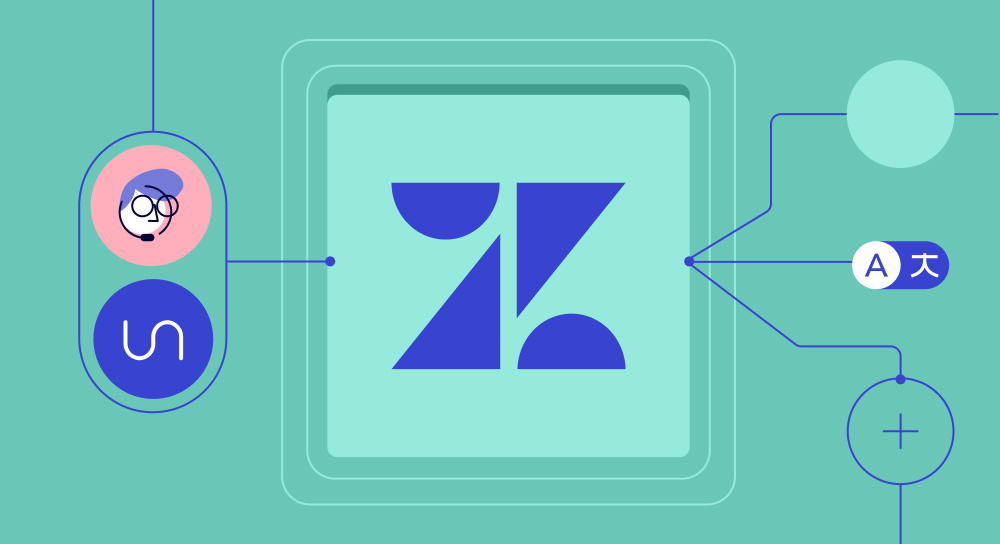 Zendesk is one of the most popular customer relationship management (CRM) tools on the market today, helping more than 100,000 companies power high-quality support interactions across millions of customers.
Zendesk is one of the most popular customer relationship management (CRM) tools on the market today, helping more than 100,000 companies power high-quality support interactions across millions of customers.
As artificial intelligence continues to evolve as a powerful force multiplier for boosting the efficiency of customer service agents, you may be wondering how exactly AI can be combined with this leading CRM to produce tangible results.
Here are three ways Zendesk users can leverage AI to improve customer operations while providing a five-star customer experience.
1. Automate routine interactions
When evaluating the ways AI can integrate with CRM software, we like to think of these applications as being either autonomous or augmented:
-
Autonomous AI is capable of executing simple tasks with minimal or no human interaction.
-
Augmented AI enhances humans’ work, allowing them to scale their existing abilities and rapidly gain new skills.
As the name suggests, automation falls under the category of autonomous AI because it focuses on solving predefined problems that are mapped to established solutions. More than one-third of Zendesk users currently leverage automation to handle common customer support questions such as “​What countries does your business ship to?” or “How many days do I have to return a product?”
Chatbots are one of the most effective and widely adopted automation technologies companies use as part of an AI-driven customer service strategy. For example, a tool like the Zendesk Answer Bot can carry out automated interactions such as quick replies, prebuilt conversational flows, and escalation to a human for more complex queries.
It’s important to recognize augmented AI’s place as a “first line” used to answer straightforward questions or route those that need a human to the appropriate channel. Customers don’t want all of their brand interactions to be with a bot. If you try to stretch the limits of what autonomous AI can do, customers will become frustrated about answer inaccuracy or that their conversations aren’t being passed along to an agent.
2. Tap into machine translation
When considering applications of augmented AI for Zendesk, you’d be hard pressed to find a more powerful, higher impact technology than machine translation designed specifically for customer service. This type of machine translation allows any support agent to communicate with any customer in their native tongue. If your business currently serves (or plans to serve) customers in more than one language, there are several high-value ways you can use machine translation for Zendesk to upgrade your globe customer service operations:
-
Design a more efficient location strategy to reduce overall costs and keep your team lean.
-
Test new markets and accelerate global growth as you identify demand in a given region.
-
Optimize your team’s efficiency and seamlessly meet seasonal surges or unexpected fluctuations in volume.
Today’s customers expect brands to localize communications to the language they speak, accounting for cultural nuances, across all functions and digital channels. When this expectation is not met, the likelihood of churn is high. Our 2021 Global Multilingual CX Report discovered that 68% of consumers across the world will switch to a different brand if they are not offered support in their native language. Quick response times (47%) and fast resolution times (46%) were also named as crucial customer service factors among survey respondents.
Fortunately, Unbabel for Zendesk enables companies in any industry to provide both the speed and quality elements that are necessary for customer service machine translation to work at scale. Our human-in-the-loop approach to AI features stronger performance than other translation engines on the market today, enabling you to achieve your business goals while maintaining or improving customer-centric KPIs such as CSAT, NPS, and CES.
3. Unlock advanced analytics
Just as AI used for automation and machine translation allows companies to do more with less, it is capable of handling much of the legwork associated with data analysis. AI expedites the timeline from when data is gathered to the point where it can be used to deliver actionable insights that improve business decision-making. When AI is combined with the data that lives inside a CRM like Zendesk, it helps identify patterns and trends in customer data which can be applied to current business contexts.
Zendesk breaks customer service analytics down into four distinct categories:
-
Customer experience analytics can be used to answer “what happened” across a variety of customer interactions and touchpoints (includes metrics like First Response Time [FRT] and Total Time to Resolution [TTR]).
-
Customer journey analytics help customer service managers understand which strategies and tactics are driving success and growing revenue (includes data about customers’ purchase history and product usage).
-
Customer retention analytics connect the dots between loyalty, retention, and customer effort by allowing support teams to identify areas of friction that are hurting the customer experience (includes metrics like Customer Churn Rate [CCR] and Customer Lifetime Value [CLV]).
-
Customer engagement analytics encompass any interaction a customer has with a brand via a digital channel (includes social media, website forms, and email surveys).
Using AI to mine historical data across the above categories can help predict the future (aka predictive analytics). For example, Zendesk’s Satisfaction Prediction tool combines support ticket content with CX metrics to forecast what a customer’s level of satisfaction will be (their CSAT score). There are many other potential applications of AI for predictive analytics, such as proactively offering enticing deals or pinpointing customers who are at a high risk for churn.
The best AI for Zendesk language translation
Unbabel is proud to be a global leader in machine translation that has a close partnership with Zendesk. To see how easy it is to get up and running with Zendesk + Unbabel, read our quick guide on integrating language translation services into Zendesk.











